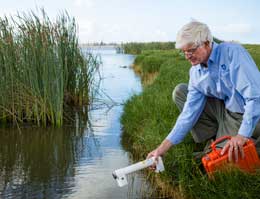17 April 2013
 A new communications system being trialled at the University of South Australia (UniSA) could radically lower the cost of using satellites to send and receive sensor information collected in Australia’s vast unpopulated areas.
A new communications system being trialled at the University of South Australia (UniSA) could radically lower the cost of using satellites to send and receive sensor information collected in Australia’s vast unpopulated areas.
The innovative signal processing system also enables a satellite to ‘hear’ thousands of different signals at once with no loss of quality.
“Imagine if you were in a room with 10,000 people, and they were all trying to talk to you at once,” says Professor Alex Grant, Director of UniSA’s Institute for Telecommunications Research (ITR) who led the project.
“This new technology makes it possible for you to hear and understand everyone, all at the same time.”
Professor Grant says the innovative system, called the Global Sensor Network, would make it easier and cheaper to investigate what is going on in Australia’s remote regions, as well as remote regions globally.
“Because Australia’s land and sea territory is vast relative to its population, much of what goes on in remote areas remains unobserved and unknown. Existing telecommunications systems only operate where people live, or are provided by expensive satellite systems affordable by relatively few users.”
Professor Grant says the network would provide a low cost, two-way satellite messaging system for many applications, such as environmental monitoring, livestock tracking, animal and fish migration research, remote control of mining and drilling sites, national security and defence, and vessel tracking.
It could, for example, monitor sea temperatures around the remote Myrmidon Reef, in the outer Great Barrier Reef system, which is the most distant point at which unusual warm water events could be detected.
The network would consist of an array of low earth orbit satellites, on board each of which is a receiver to record and process sensor data; multiple terminals on land and in the sea containing GPS receivers and sensors; and a ground-based data hub.
Each ground terminal would transmit packets of information, such as location and temperature, to a satellite. This data would be decoded and sent to a collecting hub, where it was processed into useable information.
Professor Grant says the system also works in reverse, enabling users to remotely adjust sensors and even upgrade software, all without being on site.
For the trials, researchers placed 12 terminals across Adelaide and surrounds, including one on a buoy in Gulf St Vincent and another in a lake.
Inside each shoe-box sized prototype terminal was a GPS unit transmitting its location. The water-based terminals also contained sensors for measuring water temperature.
All terminals contained advanced software which made the 12 terminals appear to a receiving system on a plane as if they were thousands of terminals, all transmitting at once. This simulated a real life scenario, where many terminals might be transmitting data simultaneously.
The plane was used as a satellite surrogate. On board was a receiving system identical to that which would be installed on a real satellite.
As the plane flew across the region, it received signals from the terminals. The signal processing system successfully ‘found’ all the terminals and received the temperature data from terminals in the water.
“This trial successfully demonstrates the new, advanced signal processing system that has been developed by the Institute for Telecommunications Research,” says Professor Grant.
Signal processing takes real world information, such as temperature, sound or GPS coordinates, and converts this into information that can be displayed or analysed.
Professor Grant says the beauty of the network is that it can process signals from thousands of on-ground terminals at the same time.
“This whole system was developed from the ground up, using advanced software signal processing techniques to achieve a cost-effective outcome. It maximises the use of precious satellite frequency bandwidth, and will enable people globally to measure and control things in remote areas that were just not viable before.”
The Global Sensor Network has been developed by a consortium led by the University of South Australia’s Institute for Telecommunications Research (ITR), and comprising COM DEV (Canada), South Australian-based SAGE Automation, DSTO, the Australian Institute of Marine Science, and the CSIRO. The research was funded by the Federal Government’s Australian Space Research Program.
ITR has a strong track record in developing real world applications, for example, developing satellite standards for one of the largest satellite communications organisations, Inmarsat, and for launching the spinoff company Cohda Wireless which is a world leader in car-to-car communications technology.
The trials and current program will wrap up in June, and the Consortium is now actively seeking opportunities to launch its satellite-ready payload for initial system demonstration and operation.
To arrange an interview, please contact:
Abbie Thomas, Marketing and Communications Coordinator, Institute for Telecommunications Research, University of South Australia, mobile 0414525492, email abbie.thomas@unisa.edu.au
Jeff Kasparian, Business Development Manager, Institute for Telecommunications Research, University of South Australia, mobile 0408 838 660, email jeff.kasparian@unisa.edu.au




